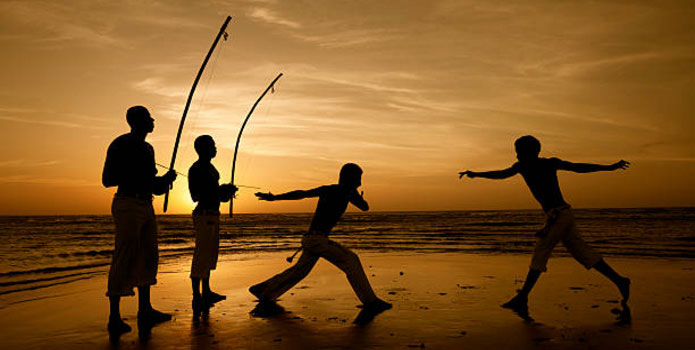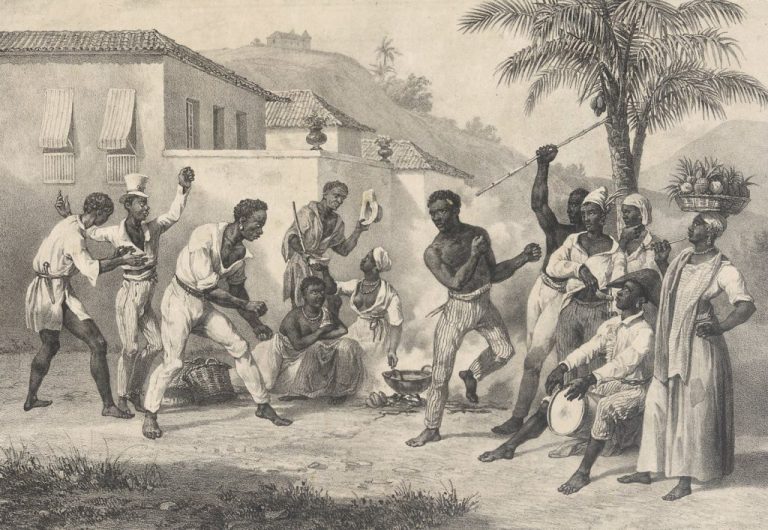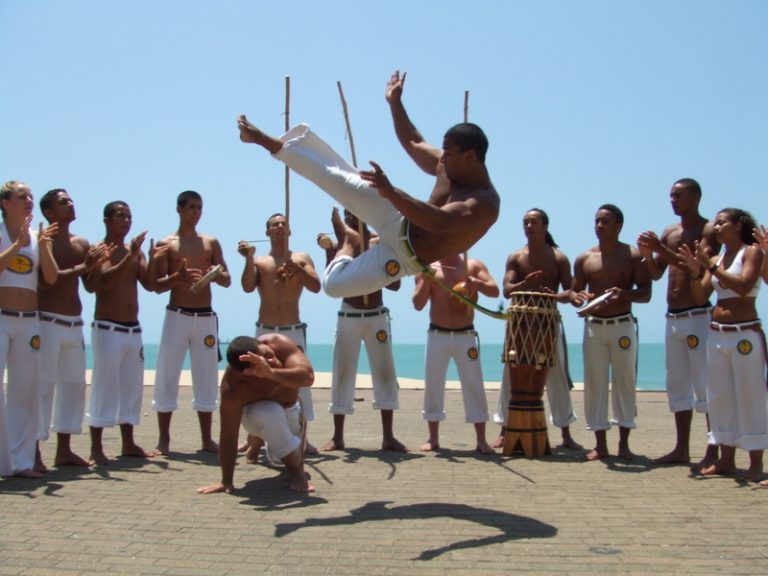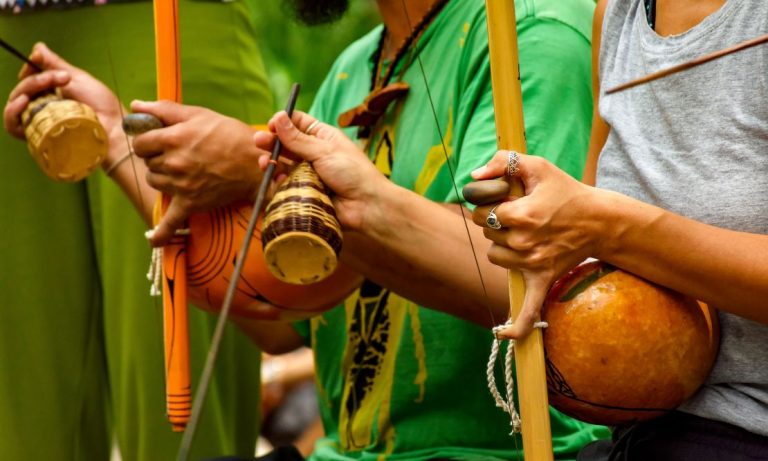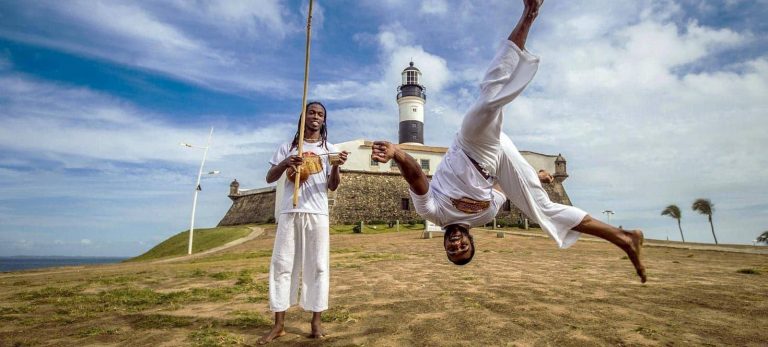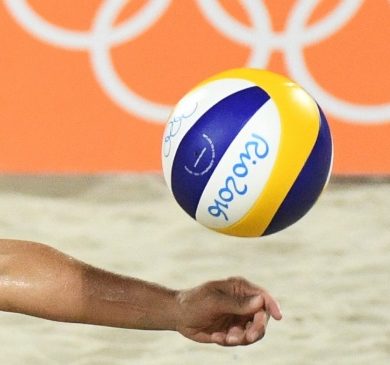Any discussion of popular sports in Brazil inevitably includes Capoeira. This integral part of Brazilian culture has spread its influence worldwide, with many cities, towns and communities now hosting their own “grupo de capoeira” led by a “Mestre de capoeira.” Capoeira continues to gain popularity so let’s explore its rich history, its role in Brazilian sports, and what it means to
be a “capoeirista” today.
Capoeira History: Struggle, Criminalization, and Triumph
Capoeira in Brazil is rooted in the combat methods practiced by enslaved Africans, primarily from Angola and Congo. These slaves were forcibly taken to Brazil by Portuguese colonizers in the 16th century. Upon their arrival, slaves were prohibited from practicing any cultural traditions, including self-defense techniques. Capoeira emerged as a covert way for slaves to preserve their culture, celebrate their heritage, and train in combat. Disguised as a dance, Capoeira allowed slaves to develop fighting techniques without alarming their masters.
Today, Capoeira’s techniques are widely used in mixed martial arts and are praised by famous combat sports stars such as Conor McGregor and José Aldo. Throughout Brazilian history, Capoeira has been misunderstood and often criminalized. It was practiced in secret until the early 20th century when “Mestre Bimba” Manuel dos Reis Machado met with then President of Brazil, Getulio Vargas. Bimba convinced Vargas of Capoeira’s cultural significance and its value as a sport for health, fitness and wellbeing. In 1930, Bimba received permission to open the first Capoeira school in Salvador de Bahia. He taught a faster, more combat-oriented version of Capoeira, known as “Capoeira Regional,” characterized by higher kicks and stricter learning codes. The more traditional form, closer to the original practices of the slaves, became known as “Capoeira Angola,” championed by Vicente Ferreira Pastinha, known as “Mestre Pastinha.”
Capoeira: Fight or Dance? The Practice of Capoeira
Capoeira is practiced in a “roda de capoeira,” a circle of practitioners who sing and clap along with Capoeira music. Observers might wonder if they are witnessing a dance or a fight. In truth, Capoeira is both and neither—it is a game (“jogo”) played between two participants who “ask and respond” to each other’s movements, showcasing their own style and responding to their partner’s actions. The rhythm (“toque”) of the berimbau, a traditional Afro-Brazilian instrument, dictates the game’s pace. Usually, the Mestre of the group plays the main berimbau (gunga) and determines whether the game is Regional, Angola, or another sub-style. To enter the roda, a player must “buy” the game, replacing one of the current players. Alternatively, the Mestre can call two players to start the roda, who then kneel in front of the gunga and cartwheel into the circle to begin the game.
The Musicality of Capoeira
Music is a fundamental aspect of Capoeira, setting it apart from other martial arts. The songs tell stories of the slaves’ suffering, their daily lives, and even mundane events. Capoeira music often reflects the Afro-Brazilian religion, Candomblé, with many of Capoeira’s values aligning with Candomblé beliefs. The music’s tempo and style influence the game’s speed and character, making it either more playful or more intense. The main instrument in Capoeira music is the berimbau, a bow with a taut wire strung between its ends, played with a small stick and resonating through a “cabaça,” a hollowed-out gourd. Other instruments include the “pandeiro” (an East-African leather tambourine), “atabaque” (tall African hand drums), the agogô, and the reco-reco. The mestre sings a verse, and all participants respond in chorus. If no music is playing, Capoeira must not be practiced.
The Elements of Capoeira: Music, Movement, and Tradition
Capoeira’s essence lies in its blend of music, movement, and tradition. The roda, the circle where Capoeira is practiced, is a space of communal energy and cultural expression. Each element within the roda—music, singing, and the game itself—contributes to Capoeira’s unique identity. The berimbau, the primary musical instrument in Capoeira, sets the rhythm for the game. It
consists of a wooden bow, a steel string, and a hollow gourd. Striking the string with a stick produces different sounds, which guide the players’ movements. The pandeiro, a type of tambourine, and the atabaque, a tall drum, add to the musical ensemble, creating a vibrant auditory backdrop. The agogô, a double bell, and the reco-reco, a scraper, further enrich the musical landscape.
Singing in Capoeira is a form of storytelling. The lyrics of Capoeira songs recount the history, struggles, and daily lives of the enslaved Africans who developed this art form. These songs often feature call-and-response patterns, where the mestre sings a verse and the participants respond in chorus. This interactive musical experience reinforces the communal aspect of Capoeira and connects practitioners to their heritage. Movement in Capoeira is characterized by its fluidity and improvisation. Players in the roda engage in a dynamic exchange of attacks and defenses, blending acrobatics, kicks, and evasive maneuvers. The ginga, Capoeira’s fundamental movement, involves a continuous swaying motion that keeps practitioners in a state of readiness. This movement, combined with cartwheels, flips, and spins, creates a visually stunning display of agility and skill.
Tradition plays a vital role in Capoeira. The art form has been passed down through generations, with each mestre contributing to its evolution while preserving its core values. Capoeira’s history is marked by resilience and adaptation, from its clandestine practice by enslaved Africans to its recognition as a symbol of Brazilian culture. Today, Capoeira schools worldwide continue to honor these traditions, teaching the art form to new generations and fostering a global community of capoeiristas.
Experiencing Capoeira in Brazil
For visitors to Brazil, experiencing Capoeira firsthand is a must. Cities like Salvador, Rio de Janeiro, and São Paulo are renowned for their vibrant Capoeira scenes. Travelers can join a roda, take a lesson, or simply watch and absorb the energy of this captivating martial art. In Salvador, the birthplace of Capoeira Regional, the Mercado Modelo and Pelourinho are popular spots to witness performances. In Rio de Janeiro, the Lapa neighborhood hosts rodas in its lively streets. São Paulo offers numerous academias where visitors can train and learn about Capoeira’s rich history. Whether you are drawn to its acrobatics, music, or cultural heritage, Capoeira offers a unique and enriching experience. As you explore Brazil, don’t miss the opportunity to witness or participate in a Capoeira roda. Feel the axé, embrace the history, and become part of this extraordinary tradition that continues to captivate and inspire people around the world. By immersing oneself in Capoeira, whether through direct participation or as an observer, one can experience a profound connection to Brazilian culture. The roda, with its music, movement, and communal energy, offers a unique window into the history and traditions of Capoeira. This martial art, born out of oppression, has transformed into a global phenomenon, celebrated for its beauty, complexity, and cultural depth.
Embracing the Spirit of Capoeira
Capoeira is more than just a martial art; it’s a cultural expression, a way of life, and a celebration of resilience and freedom. Its journey from the slave plantations of Brazil to the global stage is a testament to the enduring spirit of its practitioners. By engaging with Capoeira, whether through practice or observation, one gains a deeper appreciation for its cultural significance and the unbreakable spirit of those who kept its traditions alive.
The Influence of Capoeira
Capoeira’s influence extends beyond the roda, impacting various aspects of Brazilian society and the global community. It serves as a form of cultural diplomacy, bridging gaps between different cultures and fostering mutual understanding. Capoeira events, workshops, and festivals attract people from all over the world, creating a diverse and inclusive community of practitioners.
In educational settings, Capoeira is used to teach children about history, discipline, and physical fitness. Its emphasis on rhythm, coordination, and teamwork makes it an effective tool for holistic development. Many schools and community centers incorporate Capoeira into their programs, recognizing its value in promoting physical health, cultural awareness, and social skills. The practice of Capoeira also offers numerous health benefits. It improves cardiovascular health, enhances flexibility and strength, and boosts mental well-being. The combination of physical exertion and rhythmic music creates a therapeutic experience, reducing stress and promoting a sense of joy and fulfillment.
By supporting Capoeira schools and practitioners, we contribute to the preservation and growth of this cultural treasure. Through education, practice, and community engagement, we ensure that Capoeira continues to inspire and empower future generations. Its legacy, built on resilience and creativity, serves as a beacon of hope and a reminder of the enduring power of culture and community. In the end, Capoeira is more than just a martial art; it is a living testament to the human spirit’s capacity for resilience, creativity, and transformation. Its rich history, dynamic practice, and cultural significance make it a unique and valuable part of Brazil’s heritage. By engaging with Capoeira, we honor its past, celebrate its present, and contribute to its future as a vibrant and inspiring tradition.
